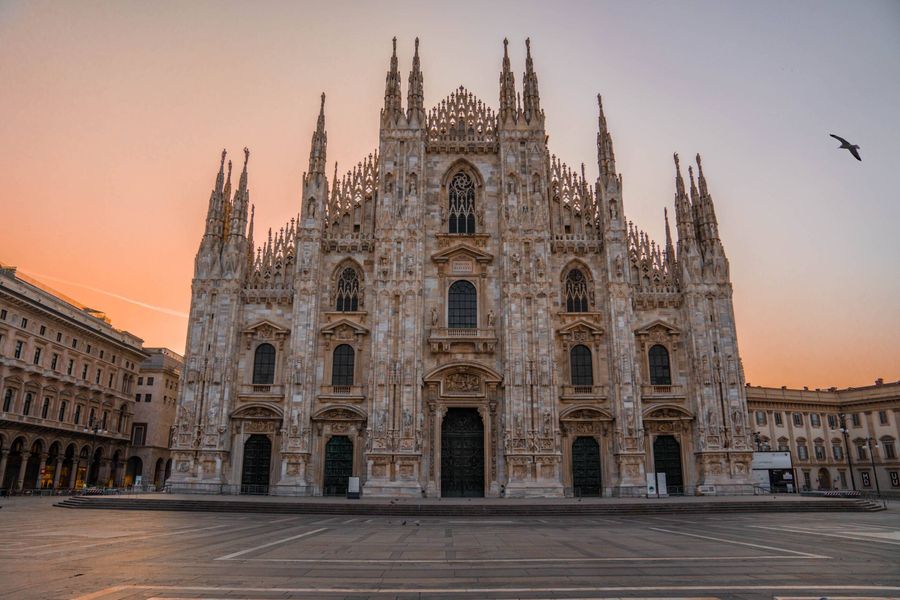
Milan
Known as Italy’s bustling financial hub and a global leader in fashion and design, Milan is a city that harmoniously blends history with modernity. While often associated with its high-end boutiques and cutting-edge architecture, Milan also boasts a rich historical legacy that dates back to Roman times. From its stunning Gothic cathedral to world-renowned masterpieces like Leonardo da Vinci’s The Last Supper, Milan is a city that offers much more than meets the eye. Whether you’re strolling through its elegant streets, marveling at its art, or indulging in Milanese cuisine, this dynamic city has something for everyone.
A City Steeped in Historical Significance
Milan’s origins date back to 600 BC, when it was founded by the Celtic Insubres. However, it was under Roman rule in the 3rd century BC that Milan, then called Mediolanum, became an important city of the Western Roman Empire. Its strategic location helped it thrive as a center for trade, culture, and military power. During the Middle Ages, Milan was at the heart of several Italian wars, but its prosperity never faded.
The city reached new heights during the Renaissance when the Sforza family ruled Milan, turning it into a flourishing center for arts, commerce, and culture. Leonardo da Vinci spent many of his productive years here, creating some of his most famous works. Even during the Industrial Revolution, Milan grew to become a symbol of Italian modernity. Today, it stands as the second-largest city in Italy and a leading force in finance, fashion, and design.
Top 5 Unique Characteristics of Milan
1. The Duomo
No trip to Milan is complete without a visit to the iconic Duomo di Milano, the largest Gothic cathedral in Italy and one of the most beautiful in the world. Construction began in the 14th century and took nearly six centuries to complete, resulting in a stunning blend of Gothic and Renaissance architectural elements. The intricate façade, spires, and thousands of statues make it a true marvel of craftsmanship. Visitors can climb to the cathedral’s rooftop to enjoy panoramic views of the city and admire the famous Madonnina, the golden statue that crowns the Duomo.
2. Leonardo da Vinci’s The Last Supper
Housed in the Convent of Santa Maria delle Grazie, Leonardo da Vinci’s The Last Supper is one of the most celebrated works of art in history. Painted between 1495 and 1498, the fresco captures the moment Jesus reveals that one of his apostles will betray him. The work’s intricate detail and emotional intensity have made it a symbol of Renaissance art. Advance booking is essential to see this masterpiece, but it is a must-visit for any art lover in Milan.
3. Galleria Vittorio Emanuele II
Opened in 1867, the Galleria Vittorio Emanuele II is one of the world’s oldest and most glamorous shopping malls. Located next to the Duomo, this grand, glass-domed gallery is home to luxury boutiques, cafés, and restaurants, making it a must-visit destination for fashion enthusiasts. Its stunning mosaics, soaring ceilings, and elegant architecture make the Galleria not just a shopping hub, but a work of art in itself. Don’t forget to spin your heel on the bull mosaic in the center for good luck!
4. Teatro alla Scala
Milan is renowned for its contributions to the world of music, and the Teatro alla Scala is the pinnacle of its musical heritage. Opened in 1778, La Scala is one of the most prestigious opera houses in the world, hosting legendary performances by composers like Verdi, Puccini, and Rossini. For music lovers, attending an opera or ballet at La Scala is a once-in-a-lifetime experience. The attached museum offers a glimpse into the rich history of Italian opera.
5. The Fashion Capital of the World
Milan is synonymous with high fashion, and it is considered one of the Big Four fashion capitals alongside Paris, London, and New York. Twice a year, during Milan Fashion Week, the city becomes the epicenter of global fashion as designers, models, and celebrities flock to showcase the latest trends. Via Montenapoleone, Milan’s most famous shopping street, is lined with luxury brands such as Gucci, Prada, and Armani, making it a must-visit for fashion enthusiasts. The city’s commitment to innovation, style, and elegance has solidified its status as a global leader in the fashion industry.
Milan Today: A Modern Powerhouse
Milan is not just about history and fashion—it is Italy’s economic engine and a global hub for finance and technology. It is home to the Italian Stock Exchange and several multinational corporations, making it one of Europe’s most important financial centers. Its vibrant design scene is highlighted during the annual Salone del Mobile, the world’s leading furniture fair, which attracts designers and architects from around the world.
The city is also famous for its thriving culinary scene, with traditional dishes like risotto alla milanese and cotoletta alla milanese making it a food lover’s paradise. Milan’s modernity, innovation, and culinary excellence attract visitors from all walks of life, making it one of Italy’s most dynamic cities.
Fun Facts About Milan
Leonardo da Vinci lived in Milan for almost 20 years, leaving a lasting impact on the city’s artistic heritage.
Milan’s Duomo has over 3,400 statues, making it the building with the most statues in the world.
The Milanese aperitivo, a tradition of pre-dinner drinks with snacks, originated in the city and is an essential part of local culture.
San Siro Stadium is one of the largest stadiums in Europe and home to two of Italy’s most famous football clubs: AC Milan and Inter Milan.
Milan was the capital of the Western Roman Empire from 286 to 402 AD.
Whether you’re exploring its rich history, indulging in world-class shopping, or enjoying the Milanese aperitivo, Milan is a city that seamlessly merges tradition and innovation. With its artistic masterpieces, architectural wonders, and modern vibrancy, Milan offers a unique and unforgettable experience for all who visit.